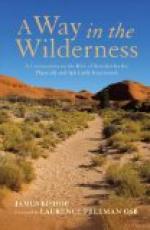If you follow the herds over the barrens and through the forest in winter, you find the same wandering, unsatisfied creature. And if you are a sportsman and a keen hunter, with well established ways of trailing and stalking, you will be driven to desperation a score of times before you get acquainted with Megaleep. He travels enormous distances without any known object. His trail is everywhere; he is himself nowhere. You scour the country for a week, crossing innumerable trails, thinking the surrounding woods must be full of caribou; then a man in a lumber camp, where you are overtaken by night, tells you that he saw the herd you are after ’way down on the Renous barrens, thirty miles below. You go there, and have the same experience,—signs everywhere, old signs, new signs, but never a caribou. And, ten to one, while you are there, the caribou are sniffing your snowshoe track suspiciously back on the barrens that you have just left.
Even in feeding, when you are hot on their trail and steal forward expecting to see them every moment, it is the same exasperating story. They dig a hole through four feet of packed snow to nibble the reindeer lichen that grows everywhere on the barrens. Before it is half eaten they wander off to the next barren and dig a larger hole; then away to the woods for the gray-green hanging moss that grows on the spruces. Here is a fallen tree half covered with the rich food. Megaleep nibbles a bite or two, then wanders away and away in search of another tree like the one he has just left.
And when you find him at last, the chances are still against you. You are stealing forward cautiously when a fresh sign attracts attention. You stop to examine it a moment. Something gray, dim, misty, seems to drift like a cloud through the trees ahead. You scarcely notice it till, on your right, a stir, and another cloud, and another—The caribou, quick, a score of them! But before your rifle is up and you have found the sights, the gray things melt into the gray woods and drift away; and the stalk begins all over again.
The reason for this restlessness is not far to seek. Megaleep’s ancestors followed regular migrations in spring and autumn, like the birds, on the unwooded plains beyond the Arctic Circle. Megaleep never migrates; but the old instinct is in him and will not let him rest. So he wanders through the year, and is never satisfied.
Fortunately nature has been kind to Megaleep in providing him with means to gratify his wandering disposition. In winter, moose and red deer must gather into yards and stay there. With the first heavy storm of December, they gather in small bands here and there on the hardwood ridges, and begin to make paths in the snow,—long, twisted, crooked paths, running for miles in every direction, crossing and recrossing in a tangle utterly hopeless to any head save that of a deer or moose. These paths they keep tramped down and more or less open all winter, so as to feed on the twigs and bark growing on either side. Were it not for this curious provision, a single severe winter would leave hardly a moose or a deer alive in the woods; for their hoofs are sharp and sink deep, and with six feet of snow on a level they can scarcely run half a mile outside their paths without becoming hopelessly stalled or exhausted.




